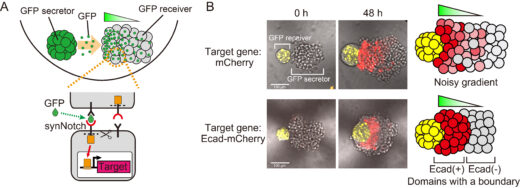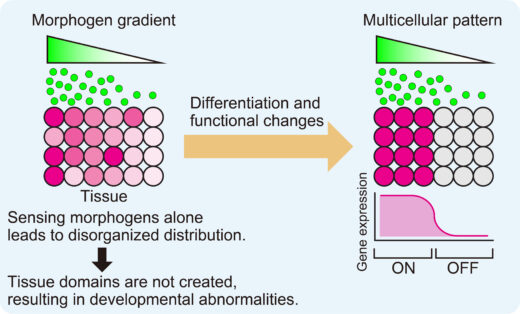Shedding light on how tissues grow with sharply defined structures
Researchers at Nano Life Science Institute (WPI-NanoLSI), Kanazawa University, demonstrate how morphogens combined with cell adhesion can generate tissue domains with a sharp boundary in an in vitro model system.
Recent advances that have enabled the growth of tissue cultures into organoids and embryoids have heightened interest as to how tissue growth is controlled during the natural processes of embryo development. It is known that the diffusion of signaling molecules called morphogens directs patterned tissue growth but what has been harder to understand is how the gradient of morphogens from this diffusion can lead to sharply defined domains in the resulting tissue (Fig. 1). Now Satoshi Toda at Kanazawa University NanoLSI (currently Osaka University, Institute for Protein Research), alongside Kosuke Mizuno at NanoLSI and Tsuyoshi Hirashima at the National University of Singapore, demonstrate a simple model system – SYnthetic Morphogen system for Pattern Logic Exploration using 3D spheroids (SYMPLE3D) – that sheds light on the process.
Various previous studies have looked at the role of morphogens and cell adhesion during tissue growth separately. However, the researchers noted a couple of recent studies indicating how a morphogen involved in neural tube patterning controls expression of a family of adhesion proteins called cadherins to form sharply defined structures. Prompted by these insights, they devised their model system to investigate the interplay between morphogens and cadherins. They highlight how in vivo morphogens induce numerous changes in cellular properties simultaneously, making it hard to disentangle what is going on. For this reason, as they highlight in the discussion of their report, “SYMPLE3D provides a new synthetic biology approach for mechanistically studying tissue patterning and engineering organoid structures.”
SYMPLE3D uses two types of cells – one, the GFP secretors, which secrete GFP and express P-cadherin forming what they describe as “GFP-secreting organizer spheroids”. The other is a GFP receiver cell, initially engineered to express a synthetic receptor called “synNotch” that recognizes GFP and induces mCherry reporter – “imC cells” (Fig. 2A).
The first stage looked at the result of co-culturing the GFP secretors and receiver cells. They found that although the imC cells did capture the secreted GFP resulting in a GFP gradient, the resulting gradient contained ectopically active cells – expression of the high-level mCherry reporter in an inappropriate position of the gradient (Fig. 2B, upper panel). To deal with the issue of ectopically active cells, Mizuno and Toda engineered GFP receiver cells to induce mCherry-fused E-cadherin, a cell adhesion molecule. To their surprise, a uniformly activated tissue domain with sharp boundary emerged instead of a gradient between the secretor and receiver cells (Fig. 2B, lower panel).

Figure 2: Tissue domain formation through the coupling of morphogen signals and cell adhesion. (A) SYnthetic Morphogen system for Pattern Logic Exploration using 3D spheroids (SYMPLE3D). (B) mCherry (upper panel) or Ecad-mCherry (lower panel) was induced in response to the GFP gradient.
The sharp boundary was also robust to changes in growth conditions. Since the addition of a single factor, E-cadherin, caused a significant change in the pattern, they then focused on the mechanism of the pattern formation process with a combination of molecular gradient and E-cadherin in their model system.
By monitoring the real time process of tissue growth, they were able to identify activated GFP receiver cells engineered to induce mCherry-fused E-cadherin were initially scattered but aggregated over the course of time. Ectopically active cells were then gradually absorbed into this active domain resulting in a sharp cut off between the mCherry positive and negative domains. They also note “an intriguing aspect” of their synthetic tissue domain, in that across the active domain the distribution of induced E-cadherin-mCherry was uniformly high, whereas GFP was distributed with a gradient. Here, they revealed a key feature of E-cadherin for the synthetic tissue domain formation. They analyzed the behavior of cells that express various levels of E-cadherin in response to different amounts of GFP and found that the behavior was the same whether the cells induced low or high levels of E-cadherin. Furthermore, they showed that cells that induced more than a certain amount of E-cadherin were able to mix with each other and form a single cell population, regardless of the expression level. Therefore, the mixing of cells that induced different levels of E-cadherin within the GFP gradient allowed the cells to receive GFP uniformly and thus the expression level of E-cadherin became evenly high in the synthetic tissue domain (Fig. 3). A simple mathematical model, developed by Hirashima, based on cell movement governed by differential adhesion energy supported their experimental observations. “Our findings suggest the possibility of programming a new tissue domain with sharp boundaries in organoids by combining synthetic morphogens with cell adhesion control,” they conclude in their report.

Figure 3: The pattern formation mechanism where morphogen signals and cadherin expression cooperate to generate tissue domains with a sharp boundary.
Note about the contributions of Kosuke Mizuno to research at the NanoLSI
Kosuke Mizuno, a second-year doctoral student in the Nano Life Science Program, has made notable contributions to NanoLSI research. He was awarded the NanoLSI Transdisciplinary Research Grant for FY2023 and FY2024.
Glossary
Morphogen
A signaling molecule that controls cell fate decision dependently on its local concentration to regulate morphogenesis. Morphogens are secreted from source cells, diffuse within tissues and form a concentration gradient that works as positional information for cell differentiation. Representative morphogens include Wnt, BMP, Shh, and retinoic acid.
Cadherins
Cadherins are a family of transmembrane proteins that facilitate cell to cell adhesion. Mizuno, Hirashima and Toda use E-cadherin and P-cadherin in the current study, which belong to the classical cadherin family. Cadherins primarily bind to each other via their homophilic extracellular domains. However, cadherins also have an intracellular domain, which binds to adaptor proteins connected to actin cytoskeletons and contributes to tissue compaction and cell sorting.
Synthetic Notch receptor (synNotch)
Notch is a signal transduction receptor. When the extracellular domain of Notch receptor binds to its ligand Delta, Notch transmembrane region is cleaved, leading to the translocation of Notch intracellular domain into the nucleus to regulate the expression of target genes. The synNotch receptor is a modified version of Notch receptor, in which the extracellular domain of Notch is replaced by an antibody or nanobody and the intracellular domain by an artificial transcription factor. Using synNotch receptors, researchers can design what ligand molecule cells recognize and what target genes cells express in response, which enables manipulation of cell-cell communications.
Article
- Title
- Robust tissue pattern formation by coupling morphogen signal and cell adhesion.
- Author
- Kosuke Mizuno, Tsuyoshi Hirashima, Satoshi Toda
- Journal
- EMBO Reports
- Publication date
- Sep 27, 2024
- DOI
- 10.1038/s44319-024-00261-z
- URL
- https://www.embopress.org/doi/full/10.1038/s44319-024-00261-z


